Abstract
Twenty four preterm infants (median birth weight 1120 g and gestation 29 weeks) were studied on 83 occasions by measuring upper airway airflow. Airway patency was detected by the transmission of cardiac impulse up the airway and airway closure by its absence. A total of 309 apnoeas of at least five seconds' duration were recorded. One hundred and eighty (58.0%) were central, 109 (35.5%) mixed, and 20 (6.5%) obstructive. Airway closure was noted in 47% of apparently central apnoeas. Airway closure occurred as apnoea lengthened; the airway remained patent in 38% of apnoeas of 5-9 seconds, 17% of those 10-14 seconds, and 11% of those 15-19 seconds' duration. Airway closure occurred in every apnoea of greater than or equal to 20 seconds. As a consequence, closed apnoeas were longer than open apnoeas (mean 9.7 v 6.6 seconds). In 72% of mixed apnoeas, airway closure was recorded during the central element and this usually preceded obstructive breaths. In 20% of mixed apnoeas and 15.5% of the total group the airways closed, having previously been patent. This occurred after a mean of 3.5 seconds (range 1-17). Mixed apnoea produced a significantly greater drop in arterial oxygen saturation than central apnoea, but only because of the greater duration of mixed apnoea. Airway closure occurs in both central and mixed apnoea and appears to be important in the pathophysiology of mixed apnoea. Central and mixed apnoea are part of a continuum of airway closure and not separate entities.
Full text
PDF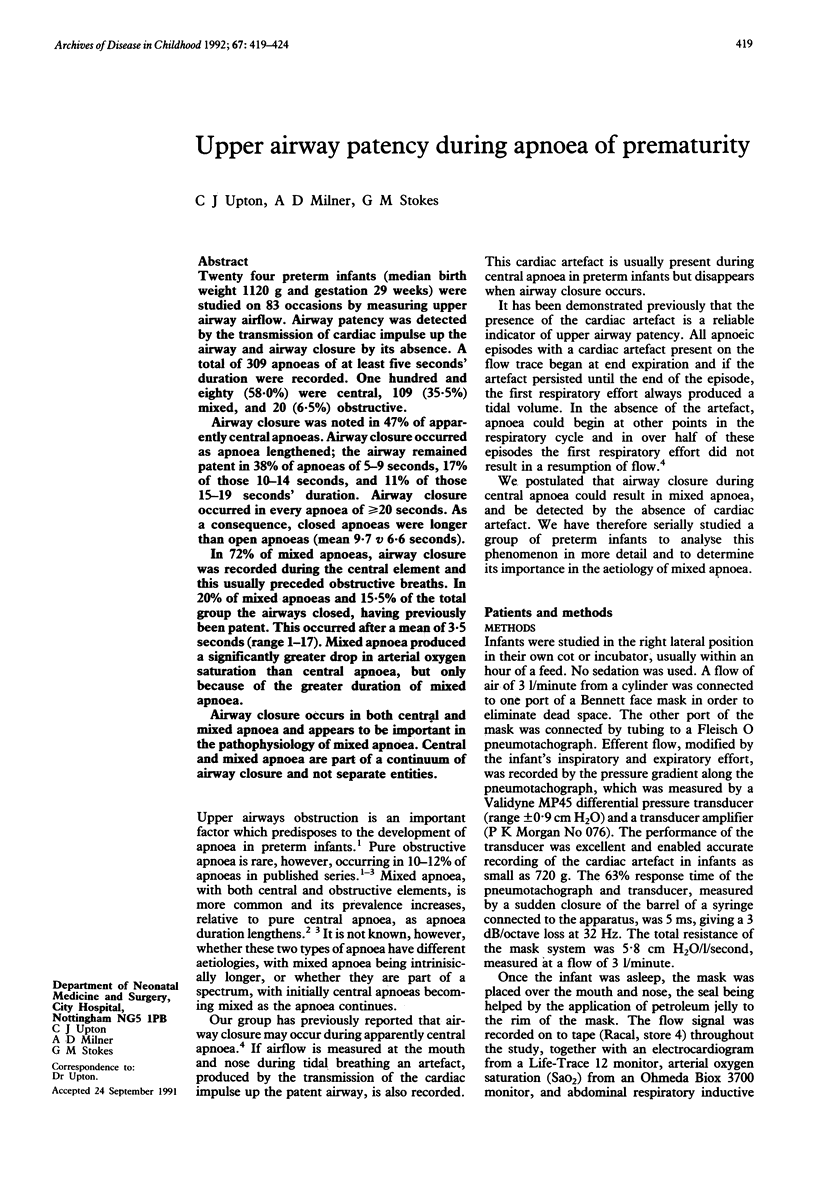
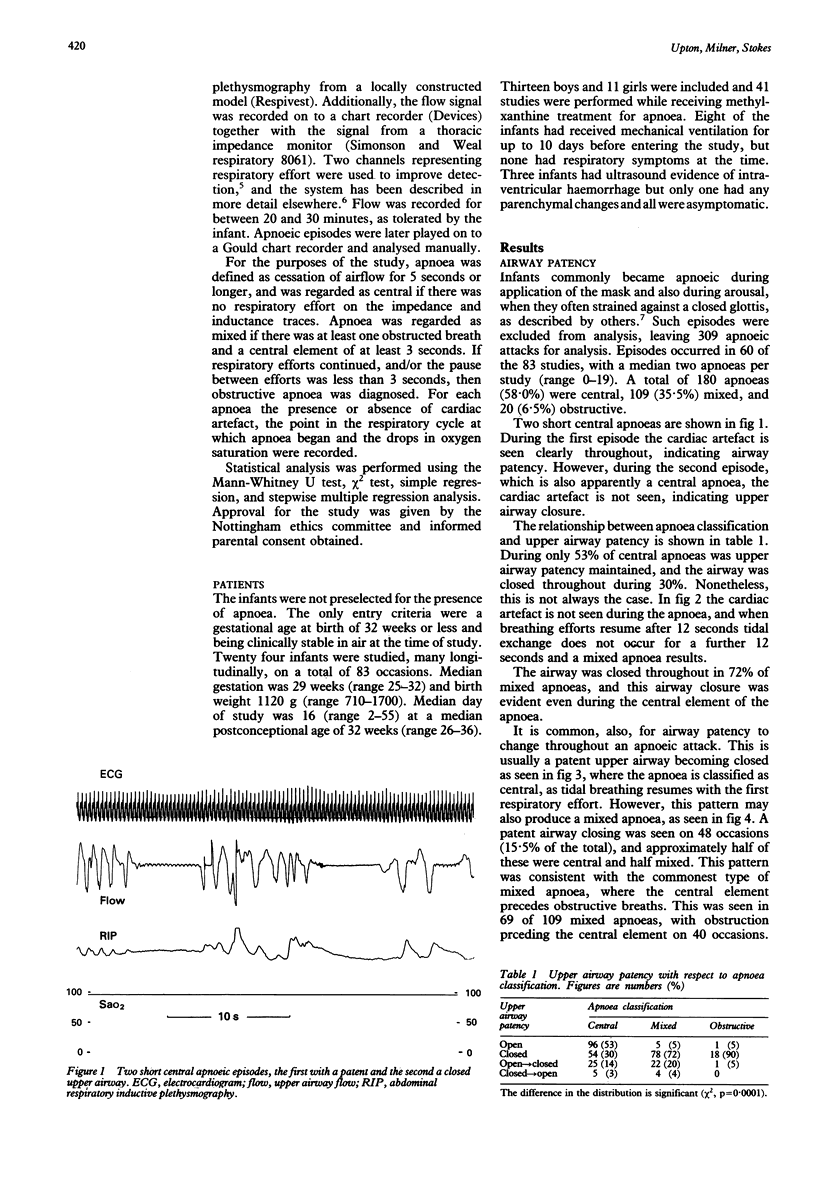
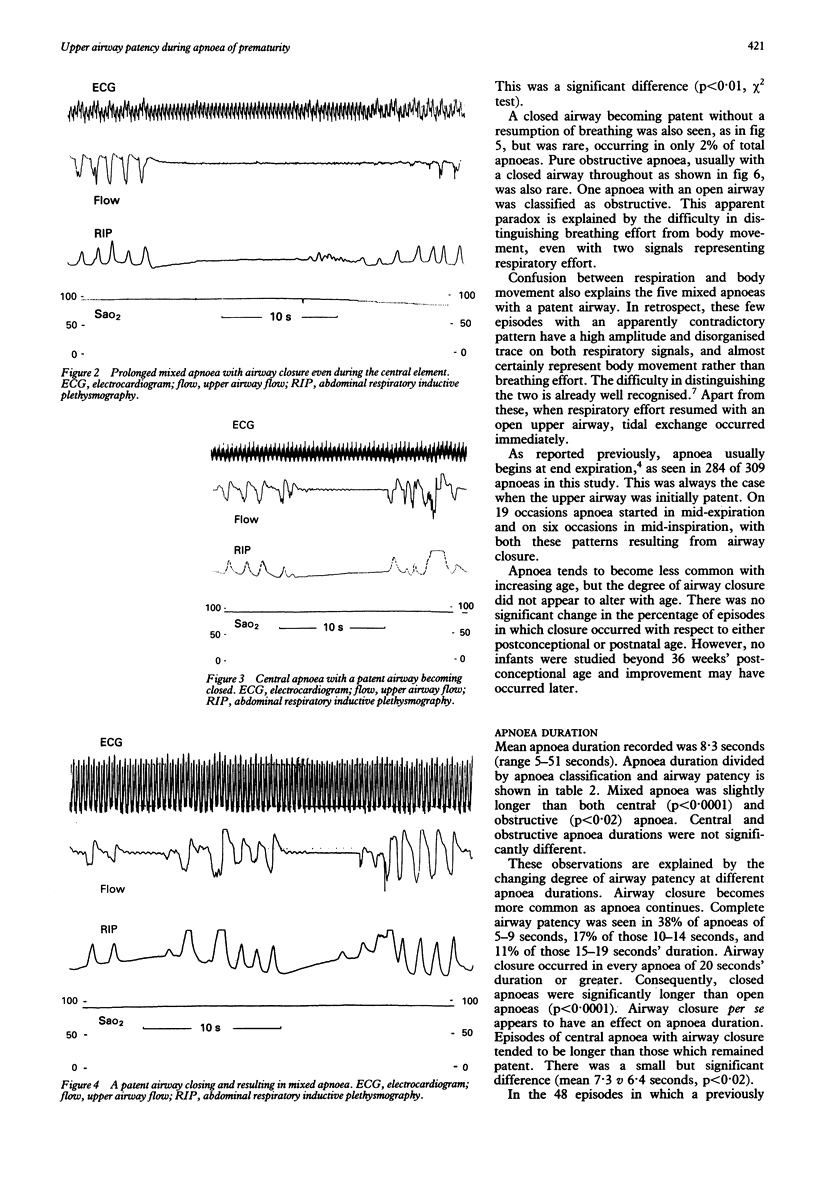
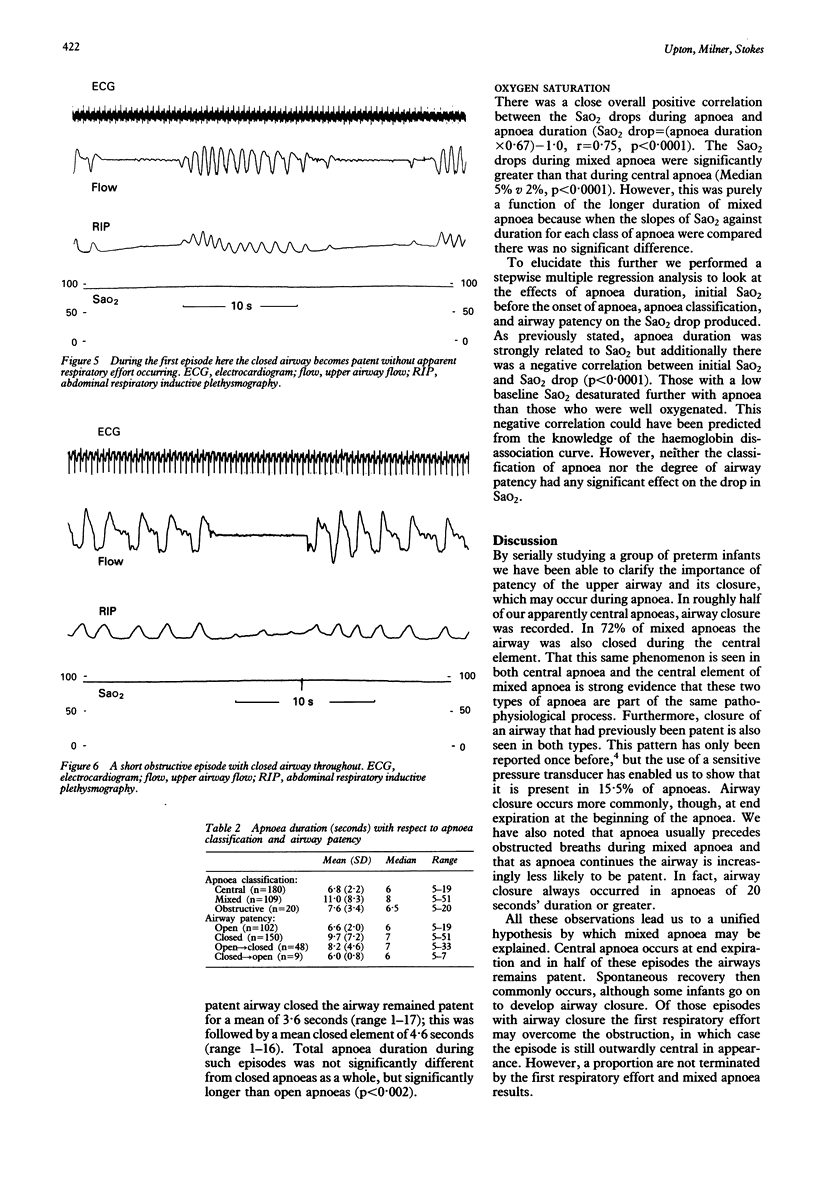
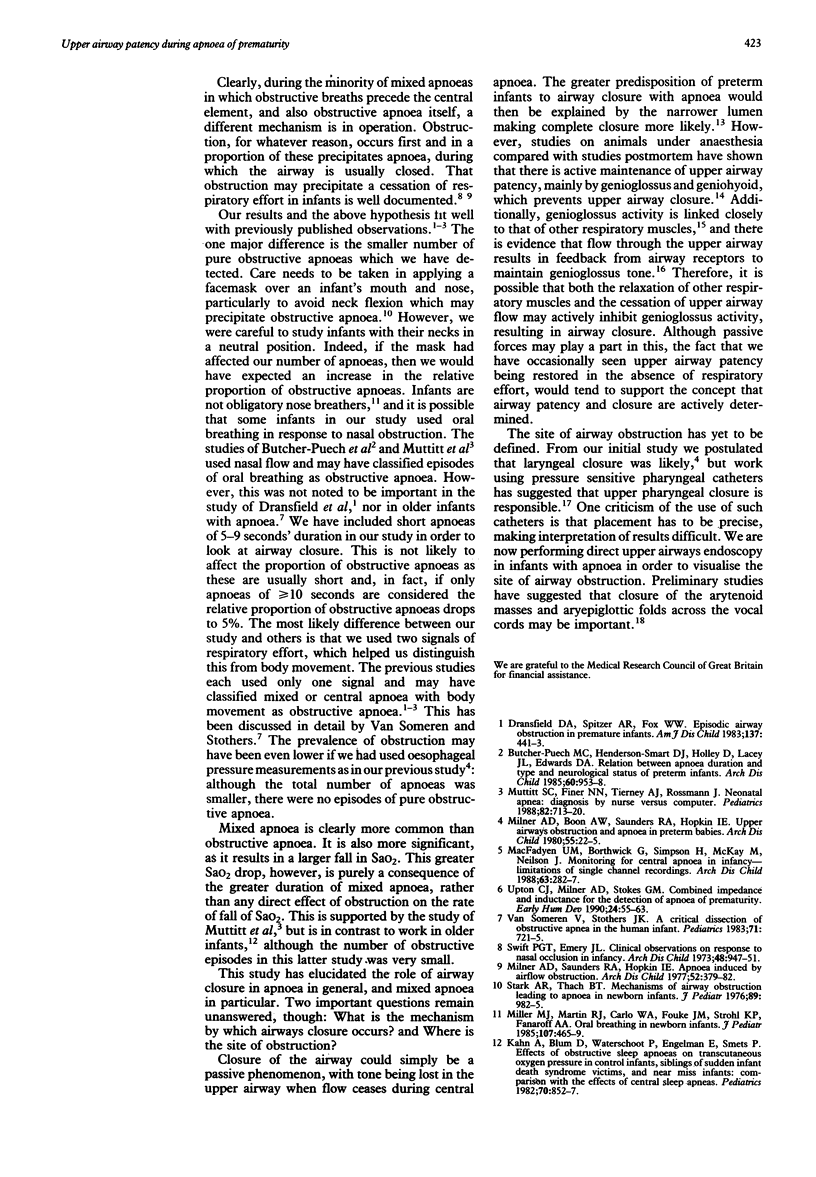
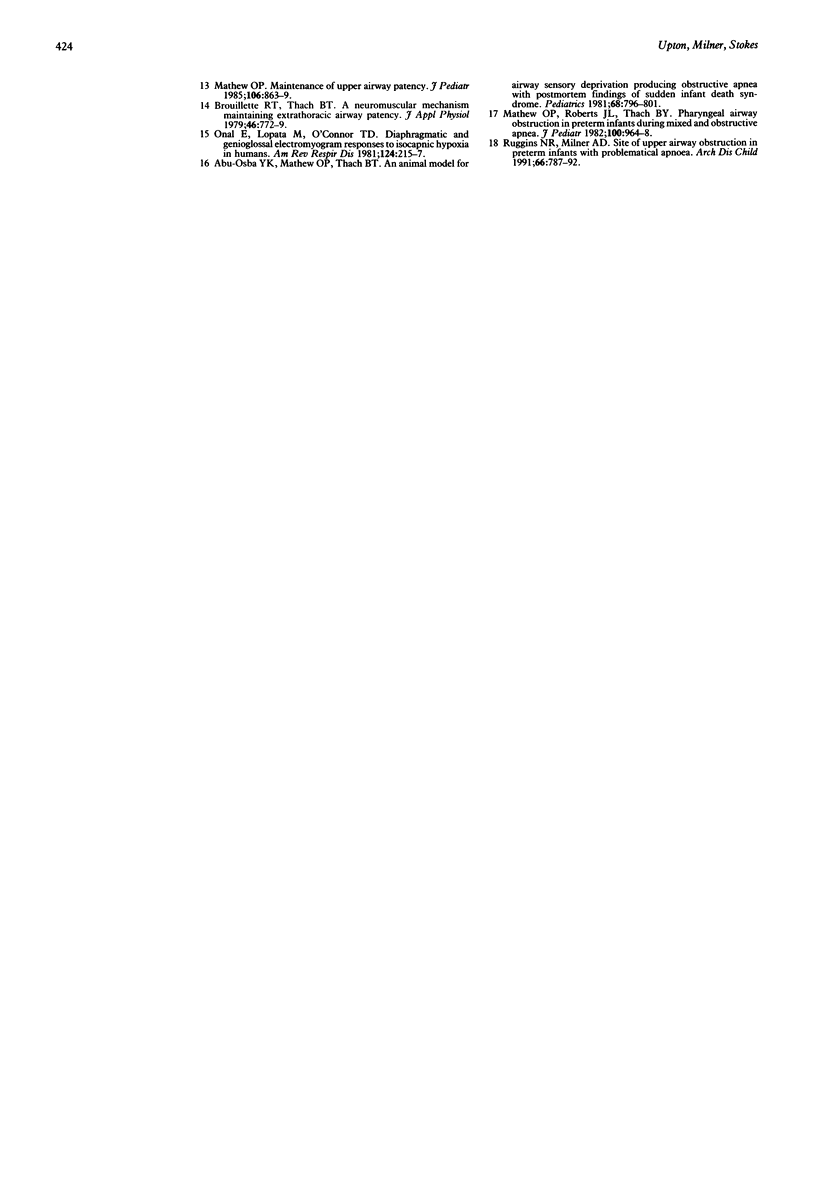
Selected References
These references are in PubMed. This may not be the complete list of references from this article.
- Abu-Osba Y. K., Mathew O. P., Thach B. T. An animal model for airway sensory deprivation producing obstructive apnea with postmortem findings of sudden infant death syndrome. Pediatrics. 1981 Dec;68(6):796–801. [PubMed] [Google Scholar]
- Brouillette R. T., Thach B. T. A neuromuscular mechanism maintaining extrathoracic airway patency. J Appl Physiol Respir Environ Exerc Physiol. 1979 Apr;46(4):772–779. doi: 10.1152/jappl.1979.46.4.772. [DOI] [PubMed] [Google Scholar]
- Butcher-Puech M. C., Henderson-Smart D. J., Holley D., Lacey J. L., Edwards D. A. Relation between apnoea duration and type and neurological status of preterm infants. Arch Dis Child. 1985 Oct;60(10):953–958. doi: 10.1136/adc.60.10.953. [DOI] [PMC free article] [PubMed] [Google Scholar]
- Dransfield D. A., Spitzer A. R., Fox W. W. Episodic airway obstruction in premature infants. Am J Dis Child. 1983 May;137(5):441–443. doi: 10.1001/archpedi.1983.02140310023005. [DOI] [PubMed] [Google Scholar]
- Kahn A., Blum D., Waterschoot P., Engelman E., Smets P. Effects of obstructive sleep apneas on transcutaneous oxygen pressure in control infants, siblings of sudden infant death syndrome victims, and near miss infants: comparison with the effects of central sleep apneas. Pediatrics. 1982 Dec;70(6):852–857. [PubMed] [Google Scholar]
- MacFadyen U. M., Borthwick G., Simpson H., McKay M., Neilson J. Monitoring for central apnoea in infancy--limitations of single channel recordings. Arch Dis Child. 1988 Mar;63(3):282–287. doi: 10.1136/adc.63.3.282. [DOI] [PMC free article] [PubMed] [Google Scholar]
- Mathew O. P. Maintenance of upper airway patency. J Pediatr. 1985 Jun;106(6):863–869. doi: 10.1016/s0022-3476(85)80227-4. [DOI] [PubMed] [Google Scholar]
- Mathew O. P., Roberts J. L., Thach B. T. Pharyngeal airway obstruction in preterm infants during mixed and obstructive apnea. J Pediatr. 1982 Jun;100(6):964–968. doi: 10.1016/s0022-3476(82)80529-5. [DOI] [PubMed] [Google Scholar]
- Miller M. J., Martin R. J., Carlo W. A., Fouke J. M., Strohl K. P., Fanaroff A. A. Oral breathing in newborn infants. J Pediatr. 1985 Sep;107(3):465–469. doi: 10.1016/s0022-3476(85)80535-7. [DOI] [PubMed] [Google Scholar]
- Milner A. D., Boon A. W., Saunders R. A., Hopkin I. E. Upper airways obstruction and apnoea in preterm babies. Arch Dis Child. 1980 Jan;55(1):22–25. doi: 10.1136/adc.55.1.22. [DOI] [PMC free article] [PubMed] [Google Scholar]
- Milner A. D., Saunders R. A., Hopkin I. E. Apnoea induced by airflow obstruction. Arch Dis Child. 1977 May;52(5):379–382. doi: 10.1136/adc.52.5.379. [DOI] [PMC free article] [PubMed] [Google Scholar]
- Muttitt S. C., Finer N. N., Tierney A. J., Rossmann J. Neonatal apnea: diagnosis by nurse versus computer. Pediatrics. 1988 Nov;82(5):713–720. [PubMed] [Google Scholar]
- Onal E., Lopata M., O'Connor T. D. Diaphragmatic and genioglossal electromyogram responses to isocapnic hypoxia in humans. Am Rev Respir Dis. 1981 Sep;124(3):215–217. doi: 10.1164/arrd.1981.124.3.215. [DOI] [PubMed] [Google Scholar]
- Ruggins N. R., Milner A. D. Site of upper airway obstruction in preterm infants with problematical apnoea. Arch Dis Child. 1991 Jul;66(7 Spec No):787–792. doi: 10.1136/adc.66.7_spec_no.787. [DOI] [PMC free article] [PubMed] [Google Scholar]
- Stark A. R., Thach B. T. Mechanisms of airway obstruction leading to apnea in newborn infants. J Pediatr. 1976 Dec;89(6):982–985. doi: 10.1016/s0022-3476(76)80615-4. [DOI] [PubMed] [Google Scholar]
- Swift P. G., Emery J. L. Clinical observations on response to nasal occlusion in infancy. Arch Dis Child. 1973 Dec;48(12):947–951. doi: 10.1136/adc.48.12.947. [DOI] [PMC free article] [PubMed] [Google Scholar]
- Upton C. J., Milner A. D., Stokes G. M. Combined impedance and inductance for the detection of apnoea of prematurity. Early Hum Dev. 1990 Oct;24(1):55–63. doi: 10.1016/0378-3782(90)90006-5. [DOI] [PubMed] [Google Scholar]
- van Someren V., Stothers J. K. A critical dissection of obstructive apnea in the human infant. Pediatrics. 1983 May;71(5):721–725. [PubMed] [Google Scholar]


